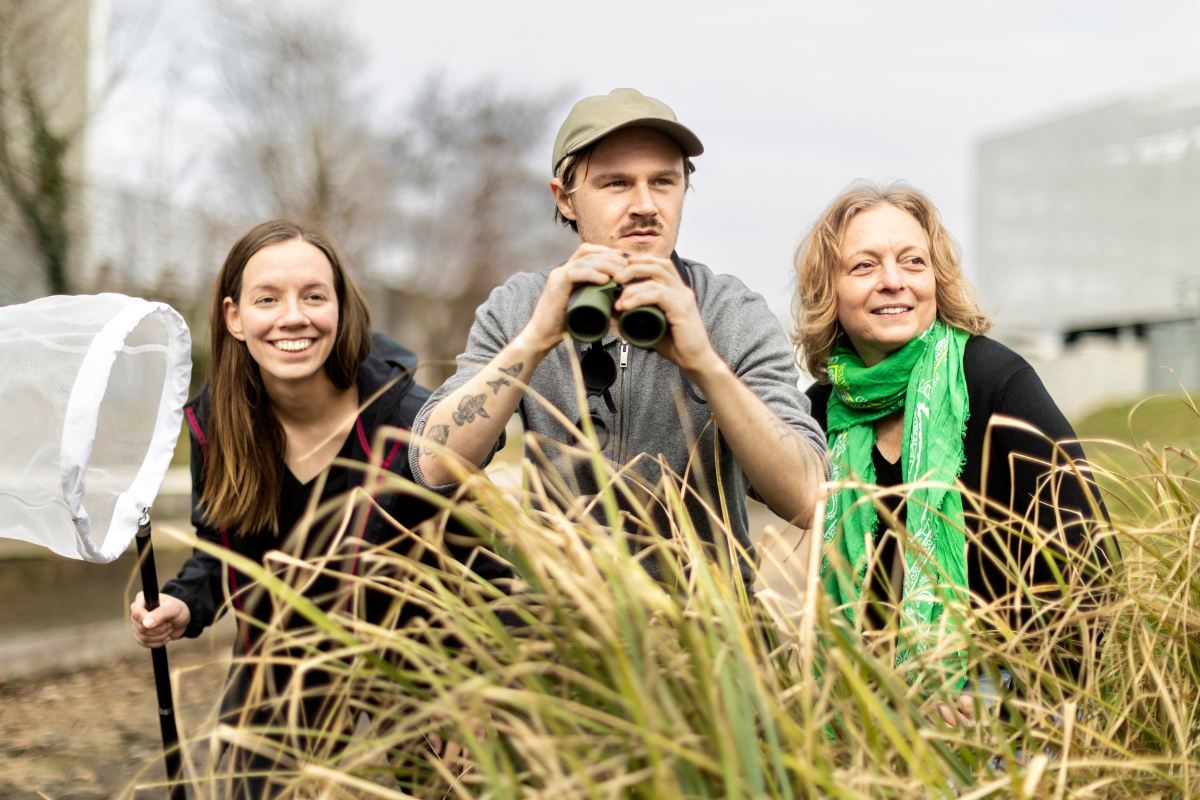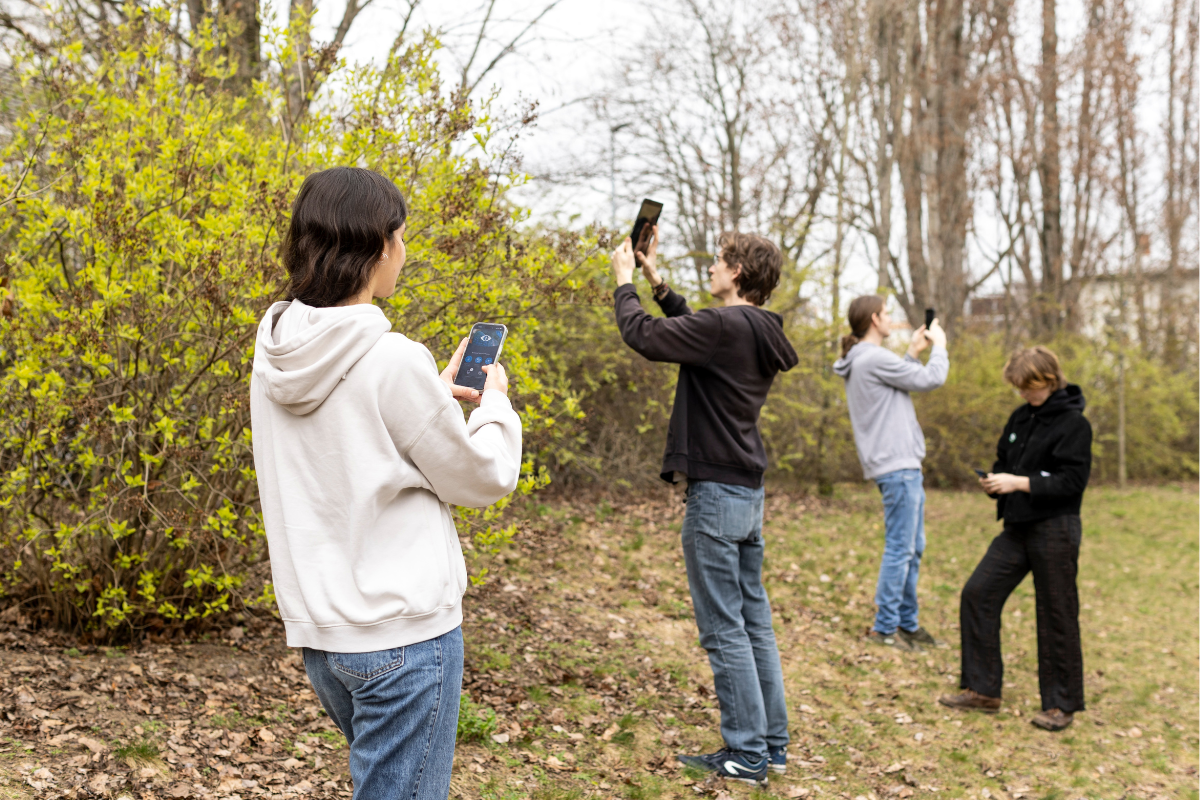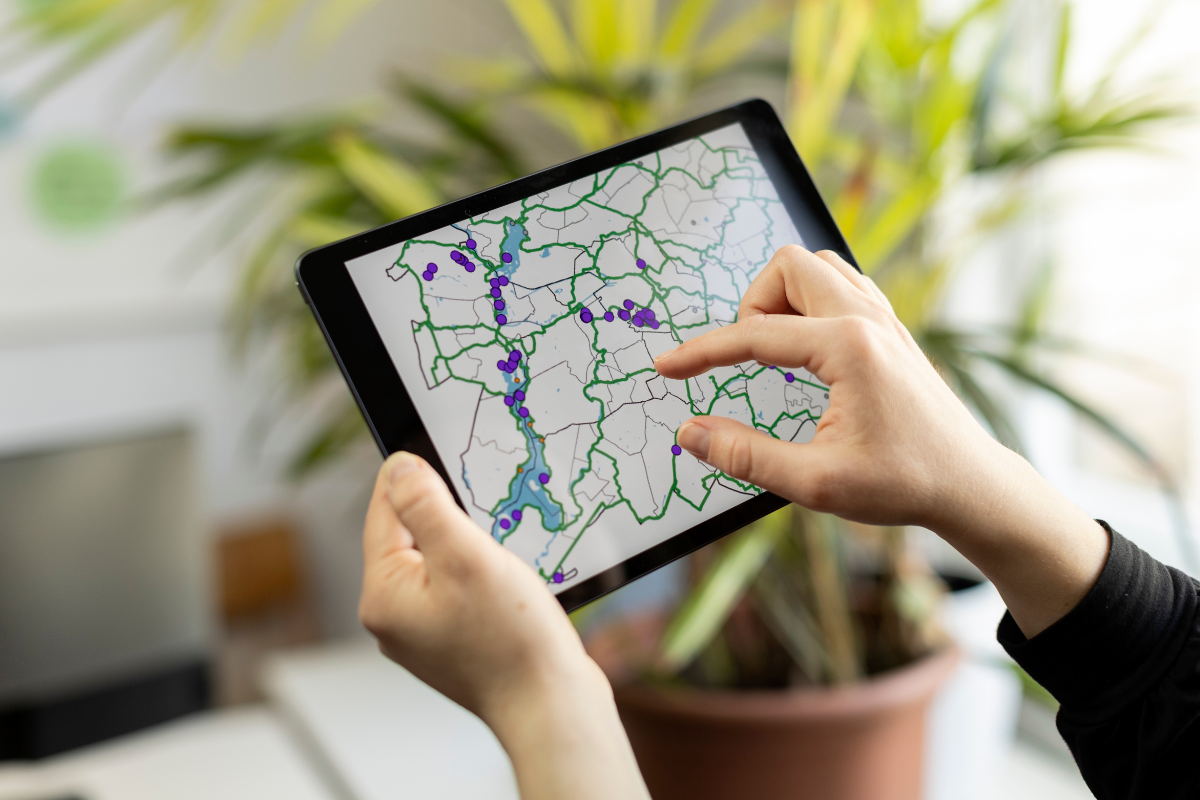On a day in spring, just a few hundred metres from the Museum für Naturkunde Berlin, Frederic Griesbaum accompanies a group of young people through the green area along the Südpanke. Three years ago, the small river in the Mitte district was opened up again, creating a nearnatural space that is attractive for people and animals. A narrow, wild niche in the dense urban space, squeezed between the high fence of the Federal Intelligence Service and the Scharnhorststraße cogeneration plant. Workshop noises echo from the nearby industrial estate. Griesbaum, a biologist at the Museum für Naturkunde Berlin who often leads groups through Berlin's urban nature, peers through his binoculars into the treetops. A starling. A hooded crow. Great tits. Two goldfinches! ‘Was that just a greenfinch?’ A pair of squirrels dart into the bushes behind him.
The group searches the slope in front of the high fence. The German Wildlife Foundation has planted a flower strip here to attract pollinators. With a trained eye, Griesbaum spies a wasp just a few millimetres in size and bright red firebugs in just a matter of moments, he points out the many nests of soil that wild bees have dug and scares up ants under a piece of bark. A shiny golden-metallic beetle shimmers between the blades of grass - and lands unceremoniously in the magnifying glass.
‘An ore-coloured canal beetle,’ says Griesbaum. ‘Insects and birds are the first to repopulate such areas, they fly by and think to themselves: it's nice here, we'll stay here!’ Flora and fauna have gratefully accepted the new space. The Berlin Nature Conservation Foundation counted 70 species of wild bees here last year and citizens have entered more than 100 species in the nature observation app iNaturalist - including leafcutter bees, which close their nests with leaves, and a red fox, which has torn open the slope to the Federal Intelligence Service as if it wanted to dig a tunnel under the fence. The south bank itself is home to gudgeon, three-spined stickleback and nine-spined stickleback, with purple loosestrife and marsh lilies growing on its banks and even the rare heather a little way off. A woman walking her dog says that she always sees a grey heron here in the morning. And indeed, you can recognise its delicate tracks in the mud.
In this place, in the middle of Berlin's urban sprawl, you can observe how nature gradually returns to the city if given the chance. And how people also feel at home in the cultivated biotopes - sitting by the water, lying on benches, letting nature work its magic on them. ‘It really is a gem that shows how biodiversity in the city can be increased through targeted enhancement measures,’ says Griesbaum.
‘In the long term, pond frogs or endangered dragonfly species could also colonise here again.’ A new project at the Museum für Naturkunde Berlin, in which Griesbaum is involved, aims to find out exactly these kinds of questions: How vital and diverse is urban nature in the neighbourhood? Where can valuable natural areas be found, however small and cramped they may be? And what can each individual do to contribute to biodiversity in the neighbourhood? ‘Vielfalt verstehen’ was launched in summer 2023 under the scientific direction of Astrid Faber, Nike Sommerwerk and Jörg Freyhof to identify all those green spaces in the districts of Mitte and Reinickendorf that are home to a particularly large number of species - or even a particularly large number of specimens of an endangered species.
However, it is not by necessary for these to be designated protected areas. A cemetery, an allotment garden or even an overgrown road median strip can also be hotspots of urban biodiversity. The diversity that can be found in these in-between spaces is sometimes surprising, even for experts,’ says Julia Kissel, who coordinates the project at the Museum für Naturkunde Berlin, which is funded by the Senate Department for Mobility, Transport, Climate Protection and the Environment. ‘There is so much that lies hidden in the centre of the city, waiting to be discovered.’
Great crested newts in Reinickendorf
For a large city, Berlin is particularly rich in species. Around 20,000 animal and plant species live here between 3.8 million people. Some species feel particularly at home in the capital. The population of Berlin nightingales, for example, is impressively high at around 3,000. The population of goshawks in Berlin is denser than almost anywhere else in Europe. And at night, 18 of the 25 bat species native to Germany buzz through the Berlin skies - around 10,000 animals hibernate in the Spandau Citadel alone, including the greater mouse-eared bat, the water bat, the common pipistrelle and the brown long-eared bat.
Some very rare animal species have also been able to survive in Berlin. On a dune in Jungfernheide, for example, there is a population of the gravel bank grasshopper, which can hardly be found anywhere else outside the Alps. A small community of sand lizards lives on the edge of Tempelhofer Feld and the natterjack toad has made itself at home on a former railway station site in Pankow. The strictly protected great crested newt has been spotted in Tegeler Forst and in the urban Kienhorstpark in Reinickendorf.
But things are looking bad for many species. As elsewhere, the trend in Berlin is towards species loss: in the 20th century, around 10 species per year disappeared from the city, and a total of 16 per cent of all species on the Red List for Berlin are considered ‘lost’. Species that depend on bodies of water in particular have suffered greatly from the climate-related drought of recent years, and wall-breeding bats and birds such as swifts and house sparrows are also having a hard time because they are finding fewer and fewer nesting sites due to house renovations.
‘Vielfalt verstehen’ will map which valuable niches exist in Mitte and Reinickendorf and raise awareness of these spaces. School classes, kindergartens and neighbourhood associations will explore the areas and experience up close who populates their neighbourhood. ‘We want to bring as many Berliners as possible into contact with urban nature and show them that biodiversity is not only found in the rainforest, but also in their own neighbourhood,’ says Griesbaum, who is responsible for the project's environmental education programme together with his colleague Kim Mortega.
This programme fits in with the extensive educational work on urban nature carried out by the Museum für Naturkunde Berlin. Every year, numerous Berliners explore local biotopes such as the Panke, the Tiergarten and the Karow ponds on nature tours. For Reinickendorf, the Museum für Naturkunde Berlin even houses the coordination centre for nature and environmental education, through which a network for environmental education is established in the district and the environmental education offers are further developed and publicised.
And with the Brunnenkiez neighbourhood in Wedding, there is a long-standing alliance with various educational institutions, where preschool children, among others, experience nature through the seasons on project days and discover nature through play. With the free Naturblick app, a digital companion has also been created that can be used to identify more than 2,500 species - partly through automatic pattern and sound recognition - and record them in a personal field book.
Shared space for people and nature
In order to gain a well-researched overview of biodiversity in the green spaces in Mitte and Reinickendorf, ‘Vielfalt Verstehen’ brings together existing data from science and the Berlin administration. ‘This could be measuring points for data on fishing from the Senate Department, bird observations from the Berlin Ornithological Consortium, plant mapping from the Berlin Nature Conservation Foundation or data from citizen science apps such as iNaturalist,’ says Melina Fienitz, who is responsible for the research work in the project together with her colleague Silvia Keinath. She checks the data sets and gradually collates them into a map, which makes it increasingly clear in which areas of the city diversity is particularly high or endangered species have found an important habitat.
The aim is not to place these areas under nature conservation, but to designate them as Key Biodiversity Areas (KBAs). This concept, created by the International Union for Conservation of Nature (IUCN), identifies areas that make a particularly significant contribution to the conservation of biodiversity - for example, because they are especially important for endangered species. In the ‘Vielfalt Verstehen’ project, this globally utilised concept is being adapted and applied to Berlin for the first time. In a large city in particular, the key biodiversity areas offer a way to promote biodiversity without depriving people of valuable areas in the city.
They function as a kind of shared space for nature and people, which considers both together and does equal justice to both. They are also an important building block for achieving the goal announced at the 2022 World Conference on Nature of effectively conserving at least 30 per cent of the world's land and sea areas by 2030. In its search for the city's green hotspots, the project also relies on the expertise of the many experts in Berlin who deal with and observe biodiversity. The Museum für Naturkunde Berlin also has its own research cluster focussing on urban nature. The researchers here analyse how individual species and species groups develop in Berlin over the years and decades, they observe wild bee populations in Berlin's community gardens and study bats, fish and amphibians.
For example, they discovered that 450 different insect species populate the central reservations of streets such as Heerstraße or Frankfurter Allee - including the grasshopper wasp, which was thought to have been lost in Berlin for over 60 years. And they are developing automatic systems for identifying and discovering species that combine genetic techniques with artificial intelligence.
For the Berlin area, the research cluster has compiled information for the 89 long-term biodiversity series, which record changes in population sizes and genetic data for rare breeding birds, butterflies and dragonflies, among others. The aim is to use them to create a comprehensive index based on the international Living Planet Index, which can be used to determine the state of biodiversity in the city at a glance - a kind of weather station for biodiversity.
The city is organised into a network of green areas
In summer, the area in front of the Museum für Naturkunde is transformed into a green oasis in the otherwise sealed and fossilised Invalidenstraße. Children and adults sit among the red, blue, yellow and purple flowers, lingering despite the noise of the cars. If you listen closely - and at the right traffic lights - you can hear the buzzing of insects. Where once there were barren lawns, there is now a colourful range for people and insects, with almost 80 plant species that bloom well into autumn. Wild bee expert: 38 species of wild bees were counted here in the first year.
Like the wild bee nests on Südpanke, the new buzzing on Invalidenstrasse also brings good news: biodiversity will increase again as soon as a green niche opens up in the concreted urban space. However, the prerequisite for this is that there are other niches nearby. ‘The fact that we had so many wild bee species on our flowering area in front of the museum in the very first year is probably also thanks to the green corridor on the Südpanke,’ says Griesbaum. The narrow strip functions like a connecting corridor for biodiversity. A whole network of such main green routes runs through Berlin - from Spandau to Müggelsee, from Buch to Marienfelde.
These are like the main arteries of urban biodiversity, along which animals can move - and plants can spread. ‘Without such habitat corridors, it would take a very long time for a renaturalised area in the centre to be extensively recolonised. Some Reinickendorf biotopes are already at the top of the list of potential key areas in Berlin: The Tegeler Fließ, for example, which is home to several highly endangered species such as the crucian carp and the mud dace, Lake Tegel and the island of Scharfenberg in its centre, which have been designated as a landscape conservation area. For many of the city's green spaces and interstitial areas, however, no one has ever comprehensively analysed what is romping around there.
‘Our data will probably also reveal new hotspots that have not yet received so much attention,’ says Fienitz. For example, a cemetery may be identified as a key area or a previously overlooked brownfield site. The list of key areas in Berlin will be public. Nature conservation organisations or foundations can use it as a basis for planning and strengthening existing biotopes, for example to network habitats and create new distribution routes through so-called stepping stone biotopes that can close gaps. The city administration should also be able to benefit from the biodiversity data collected and use it in future urban planning, for example. ‘We want to provide impetus for sustainable urban development and make suggestions on how areas can be enhanced through simple measures,’ says project coordinator Kissel. ‘Biodiversity can thus be better taken into account when planning development projects.’
Educational work is just as important to the team. After all, the future key areas are ideal for experiencing nature. As with protected areas, biodiversity is particularly high here, but access is free. School classes, local residents and neighbourhood associations will be given the opportunity to take on sponsorships, maintain areas and collect data on local biodiversity, which in turn will feed into further research work. The long-term data series on individual species will also be continued together with many partner organisations of the Museum für Naturkunde Berlin. ‘Through this kind of participation, participants can make a difference right on their own doorstep,’ says Kissel. ‘These opportunities to shape and participate create identification with the neighbourhood and nature on the doorstep and also strengthen the social fabric.’
To ensure that the commitment to Berlin's biodiversity can become more independent in the future, ‘Vielfalt Verstehen’ publishes guidelines for enhancing urban nature and offers events on urban biodiversity at garden schools, environmental centres, for allotment garden associations and housing cooperatives. Over time, an extensive network is created that promotes nature in the city. Initially in Mitte and Reinickendorf, later also in other districts.
Not only citizens and experts are part of ‘Understanding Diversity’, educators such as teachers are also an important target group. This is because they playfully introduce schoolchildren to the exploration and protection of biodiversity and shape it for their lives. Here, too, the aim is to reach those who otherwise have little contact with nature in their everyday lives. ‘We want to convey that nature in the city is of great value to people, especially when it comes to recreation. But it also has needs and needs its space,’ says Griesbaum. ‘And that it is necessary to learn to live well together with animals and plants in our neighbourhood. Ultimately, it's about all Berliners getting along well with each other - whether it's people or other living creatures.’


